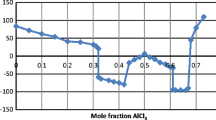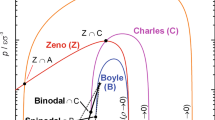Abstract
Viscosity B-coefficients for cesium chloride and lithium sulfate in methanol + water mixtures at 25 and 35 °C are reported. A general treatment of the quasi-thermodynamics of viscous flow of electrolyte solutions is described. ΔG Θ3 (1→1′), the contribution made to the Gibbs energy of activation of the solution by the influence of the solute on the solvent, is a function of solute–solvent interactions only; but, ΔH Θ3 (1→1′) and ΔS Θ3 (1→1′) also reflect the solvent–solvent interactions. In aqueous solution all alkali-metal ions except Li+ are sterically unsaturated, having solvent co-ordination numbers n<n max , the maximum allowed sterically. Such complexes exchange molecules with the solvent more readily than saturated ones and have energy–reaction co-ordinate diagrams in forms that explain the negative B or ΔG Θ3 (1→1′) values found in aqueous solution. Saturated complexes are the norm in non-aqueous solvents, and the ΔG Θ3 (1→1′) values are determined mainly by the secondary solvation. Behavior in mixed solvents reflects the transition from aqueous to non-aqueous behavior across the range of solvent composition.
Similar content being viewed by others
References
Feakins, D., Freemantle, D.J., Lawrence, K.G.: Transition state treatment of the relative viscosity of electrolyte solutions. J. Chem. Soc. Faraday Trans. I 70, 795–806 (1974)
Feakins, D., Waghorne, W.E., Lawrence, K.G.: The viscosity and structure of solutions. Part 1. A new theory of the Jones-Dole B-coefficient and the related activation parameters. Application to aqueous solutions. J. Chem. Soc. Faraday Trans. I 82, 563–568 (1986)
Feakins, D., Canning, F.M., Mullally, J.J., Waghorne, W.E.: The thermodynamics of solutions. Pure Appl. Chem. 61, 133–142 (1989)
Feakins, D., Bates, F.M., Waghorne, W.E., Lawrence, K.G.: Relative viscosities and quasi-thermodynamics of solutions of tert.-butyl alcohol in the methanol–water system: a different view of the alkyl–water interaction. J. Chem. Soc. Faraday Trans. I 89, 3381–3385 (1993)
Neilson, G.W., Mason, P.E., Ramos, S., Sullivan, D.: Neutron and X ray scattering studies of hydration in aqueous solutions. Philos. Trans. Roy. Soc. A 359, 1575–1591 (2001)
Heinzinger, K.: The structure of aqueous electrolyte solutions as derived from MD (molecular dynamics) simulations. Pure Appl. Chem. 57, 1031–1042 (1985)
Samoilov, O.Ya.: A new approach to the study of hydration of ions in aqueous solution. Discuss. Faraday Soc. 24, 1031–1042 (1957)
Ives, D.J.G., Marsden, P.: The ionisation functions of di-isopropylcyanoacetic acid in relation to hydration equilibria and the compensation law. J. Chem. Soc., 649–676 (1965)
Ben-Naim, A.: A simple model for demonstrating the relation between solubility, hydrophobic interaction, and structural changes in the solvent. J. Phys. Chem. 82, 874–885 (1978)
Frank, H.S., Evans, M.W.: Free volume and entropy in condensed systems III entropy in binary liquid mixtures; partial molal entropy in dilute solutions; structure and thermodynamics in aqueous electrolytes. J. Chem. Phys. 13, 507–532 (1945)
Frank, H.S., Wen, W.-Y.: Structural aspects of ion-solvent interaction in aqueous solutions: A suggested picture of water structure. Discuss. Faraday Soc. 24, 133–140 (1957)
Glasstone, S., Laidler, K.J., Eyring, H.: The Theory of Rate Processes. McGraw-Hill, New York (1941), p. 480
Hickey, K., Waghorne, W.E., Sacco, A.: Comparison of the activation free energies for viscous flow and for diffusion in dilute solutions, derivation of the expression for the effect of the solute on the activation free energy of diffusion of the solute, and application to solutions of N,N-dimethylformamide in water, ethanol, and acetonitrile. J. Phys. Chem. 105, 1093–1096 (2001)
de Valera, E., Feakins, D., Waghorne, W.E.: Relationship between the enthalpy of transfer of a solute and the thermodynamic mixing functions of mixed solvents. J. Chem. Soc. Faraday Trans. I 79, 1061–1071 (1983)
Crudden, J., Delaney, G.M., Feakins, D., O’Reilly, P.J., Waghorne, W.E., Lawrence, K.G.: The viscosity and structure of solutions. Part 2. Measurement of the B coefficients of viscosity for alkali-metal chlorides in propan-1-ol–water mixtures at 25 and 35 °C. J. Chem. Soc. Faraday Trans. I 82, 2195–2206 (1986)
Feakins, D., Khoo, K.H., Lorimer, J.P., O’Shaughnessy, D.A., Voice, P.J.: Washburn numbers. Part 2. Alkali metal chlorides in the methanol + water and dioxan + water systems; sodium halides in the methanol + water system. Results, formal relationships, interpretation and preferential solvation. J. Chem. Soc. Faraday Trans. I 72, 2661–2680 (1976) and references therein
Righellato, E.C., Davies, C.W.: The extent of dissociation of salts in water. Part II. Uni-bivalent salts. Trans. Faraday Soc. 26, 592–599 (1930)
Kaminsky, M.: Concentration- and temperature-dependence of the viscosity of aqueous solutions of strong electrolytes. II. Sodium chloride, lithium sulfate, ferrous chloride, and cerium chloride solutions. Z. Phys. Chem. N.F. 8, 173–191 (1956)
Millero, F.J.: The molal volumes of electrolytes. Chem. Rev. 71, 147 (1971)
Hodges, A.M., Kilpatrick, N.W., McTigue, P., Perera, J.M.: The solvation potential at the interface between water and methanol + water mixtures. J. Electroanal. Chem. 215, 63–82 (1986)
Crickard, K., Skinner, J.F.: Negative viscosity B coefficients in nonaqueous solvents. J. Phys. Chem. 73, 2060–2062 (1969)
Crudden, J., Delaney, G.M., Feakins, D., O’Reilly, P.J., Waghorne, W.E., Lawrence, K.G.: The viscosity and structure of solutions. Part 3. Interpretation of the thermodynamic activation parameters for propan-1-ol–water–electrolyte systems. J. Chem. Soc. Faraday Trans. I 82, 2207–2219 (1986)
Bicknell, R.T.M., Lawrence, K.G., Feakins, D.: Ionic viscosity B coefficients in dimethyl sulphoxide at 25, 35 and 45 °C. J. Chem. Soc. Faraday Trans. I 76, 637–647 (1980)
Newsome, J., Neilson, G.W., Enderby, J.E.: Lithium ions in aqueous solution. J. Phys. C Solid State Phys. 13, L923–L926 (1980)
Feakins, D., O’Neill, R.D., Waghorne, W.E., Ward, A.J.I.: The Erdey-Grúz experiment. Relative solvent transport numbers for ion constituents in mixtures of water with raffinose, glycine, allyl alcohol, dimethylsulphoxide and dioxan. J. Chem. Soc. Faraday Trans. I 78, 1431–1449 (1982)
Feakins, D., O’Neill, R., Waghorne, W.E.: Preferential solvation of ions and solvent transport. Pure Appl. Chem. 54, 2317–2326 (1982)
Robinson, R.A., Stokes, R.H.: Electrolyte Solutions, 2nd edn. Butterworth, London (1959), p. 70
Feakins, D., Hickey, B.E., Knox, M., McCarthy, P.J., Waghorne, W.E., Clune, T.A.: Thermodynamics of ion solvation in mixed aqueous solvents. Part 2. Effect of steric hindrance on free energies of transfer of cations; correlations with structural determinations. J. Chem. Soc. Faraday Trans. I 84, 4219–4233 (1988)
Neilson, G.W., Adya, A.K.: Neutron diffraction studies on liquids. Ann. Rep. Chem. Sect. C Roy. Soc. Chem. 93, 101–145 (1997)
Bernal, J.D., Fowler, R.H.: A theory of water and ionic solution, with particular reference to hydrogen and hydroxyl ions. J. Chem. Phys. 1, 515–548 (1933)
Skipper, N.T., Neilson, G.W., Cummings, S.C.: An X-ray diffraction study of Ni(aq)2+ and Mg(aq)2+ by difference methods. J. Phys. Condens. Matter 1, 3489–3506 (1989)
Hewish, N.A., Neilson, G.W., Enderby, J.E.: Environment of Ca2+ ions in aqueous solvent. Nature (London) 297, 138–139 (1982)
Powell, D.H., Barnes, A.C., Enderby, J.E., Neilson, G.W., Salmon, P.S.: The hydration structure around chloride ions in aqueous solution. Faraday Discuss. Chem. Soc. 85, 137–146 (1988)
Némethy, G., Scheraga, H.A.: Structure of water and hydrophobic bonding in proteins. I. A model for the thermodynamic properties of liquid water. J. Chem. Phys. 36, 3382–3400 (1962)
Franks, F., Ives, D.J.G.: The structural properties of alcohol–water mixtures. Q. Rev. Chem. Soc. 20, 1–44 (1966)
Kaminsky, M.: Ion-solvent interaction and the viscosity of strong-electrolyte solutions. Discuss. Faraday Soc. 24, 171–179 (1957)
Jenkins, H.D.B., Marcus, Y.: Viscosity B-coefficients of ions in solution. Chem. Rev. 95, 2695–2724 (1995)
Feakins, D., Watson, P.: Studies in ion solvation. Part II. Properties of ion constituents. J. Chem. Soc., 4734–4741 (1963)
Drew, M.G.B.: Structures of high coordination complexes. Coord. Chem. Rev. 24, 179–275 (1977)
Author information
Authors and Affiliations
Corresponding author
Rights and permissions
About this article
Cite this article
Feakins, D., Bates, F.M. & Waghorne, W.E. Quasi-thermodynamics of Viscous Flow of Electrolyte Solutions in Aqueous, Non-aqueous and Mixed Aqueous Solvents. J Solution Chem 37, 727–747 (2008). https://doi.org/10.1007/s10953-008-9271-5
Received:
Accepted:
Published:
Issue Date:
DOI: https://doi.org/10.1007/s10953-008-9271-5




